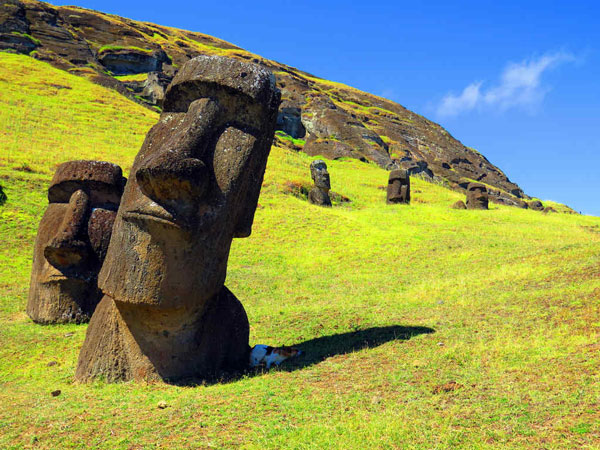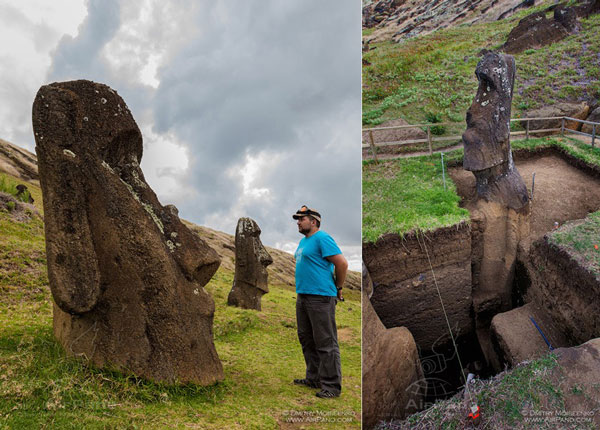Discover concussion about the body under the statue of Easter Island
Stone statues on Easter Island have been discovered by archaeologists in the lower body, containing many mysteries and important bases of civilization on the island.
Mysterious body under the statue of Easter Island
887 Moai statues , the works of the Rapa Nui people, the first inhabitants on the island (settling from 300 - 400) carved in the mid-1250 - 1500 years, at the place believed to be the first place where King Rapa Nui was Hoto-Matua first moored in the Aneka area. This area is now one of the rare beaches of the rocky island.

Moai stone statues on Easter Island remain a mysterious question to mankind.
Until today, science still has a headache before the question, what Rapa Nui people build Moai statues to do and how they move giant statues buried throughout the island.
For a long time, many people thought that Moai statues simply had the head raised above the ground but nothing more. However, a recent finding shows that the part that is buried deep in the ground of Moai statues is much more than what appears on the surface.

This is the submerged section of Moai statues.

No one expected under the statues of Moai to contain a giant statue.
According to Architecturendesign, most of the bodies of statues are buried underground, and covered with words called petroglyphs . According to the measurement, Moai statues weigh up to 75 tons and height of about 10m, especially there are 270 tons and 21m high. The long-standing secrets of the Easter Island statue will most likely be deciphered by stone carvings on the statue.
In addition, the body of the Moai has carved ancient details, circular and knotted rings, believed to symbolize the boats of the local Polynesian people, but this is only a fake. theory.

Circles and knotted shapes on the Moai stone statue.

These are said to be characters that can decipher secrets about the Moai statue.
Scholars have speculated that these figures represent ancestors or important figures who lead the Rapa Nui tribe - the first tribe to set foot on Easter Island. Some other theories suggest that this is the symbol of the sun and rainbow.
The digging under the body also helped scientists discover salmon bones, which led to a hypothesis, statues that embody the wish for food including salmon and oysters for residents. here.

The cut illustration shows the lower body of the Moai statue which has been hidden deep underground for centuries.
Easter Island (also known as Rapa Nui Island) is an island located off the west coast of Chile about 3,700 km. This is one of the most mysterious places in the world with the appearance of stone statues called Moai . The island was discovered by Dutch explorer, naval admiral Jacob Roggeveen in 1772 on Easter day. Stone statues on the island were once thought to symbolize a forgotten civilization in the past.

The excavation opens up many hopes for humankind on the island of Easter.

Many people just thought that the Easter statue had only the first part.

The mystery of meaning is the reason for moving giant statues.

The answer to this mystery seems to be gradually being revealed.
- Revealing the mystery of the statue on Easter Island
- Mysterious bacteria on Easter Island
- Scientists reveal new discoveries about Easter Island
- The origin and meaning of Easter
- Anti-aging medicine under the giant statue on Easter Island
- The mysterious story of ethnicity suddenly disappeared 160 years ago
- Aliens have appeared on Easter Island?
- How did Easter Island decline?
- The most exotic islands in the world
- The Easter Island compound extends the life of the mouse
- Reveal the mystery of traces on the
- What do countries eat on Easter?
 The truth about the mysterious red-haired giant at Lovelock Cave
The truth about the mysterious red-haired giant at Lovelock Cave Inunaki Tunnel: The haunted road leading into Japan's 'village of death'
Inunaki Tunnel: The haunted road leading into Japan's 'village of death' The mystery of the phenomenon of human reflection before dying
The mystery of the phenomenon of human reflection before dying 6 mysterious phenomena, although science has been developed for a long time, still cannot be answered
6 mysterious phenomena, although science has been developed for a long time, still cannot be answered